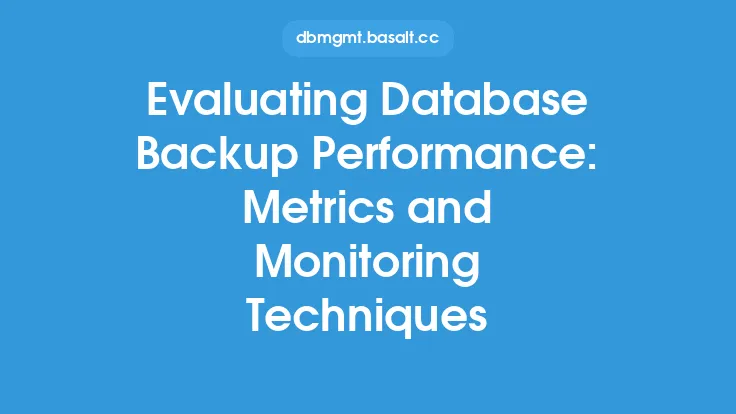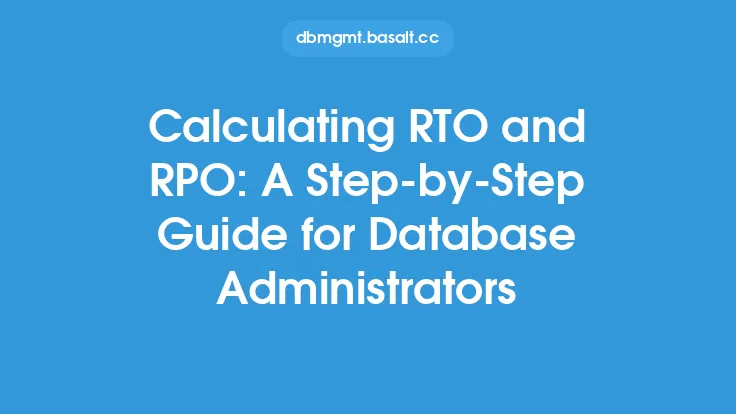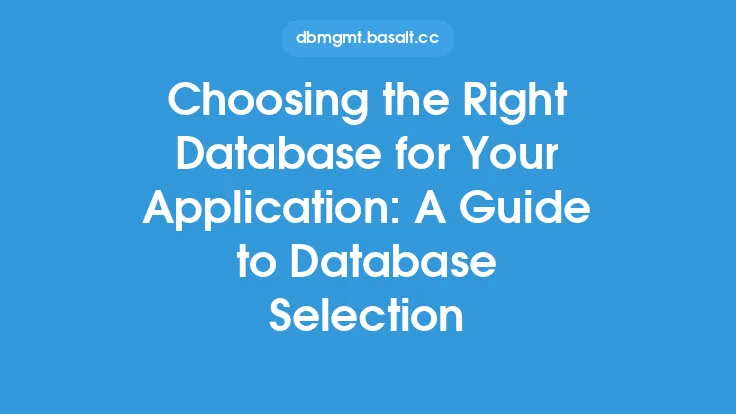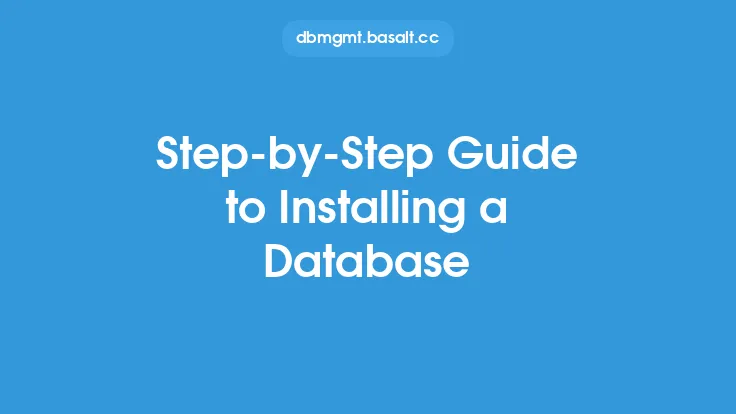Database performance monitoring and alerting are crucial aspects of maintaining a healthy and efficient database system. As databases continue to grow in size and complexity, it's essential to have a robust monitoring and alerting system in place to detect potential issues before they become critical. In this article, we'll delve into the world of database performance monitoring and alerting, exploring the key concepts, techniques, and best practices for ensuring optimal database performance.
Introduction to Database Performance Monitoring
Database performance monitoring involves tracking and analyzing various metrics and indicators to gauge the overall health and performance of a database system. This includes monitoring CPU usage, memory usage, disk space, query execution times, and other key performance indicators. The primary goal of database performance monitoring is to identify potential bottlenecks, detect anomalies, and prevent downtime or data loss. By monitoring database performance in real-time, database administrators (DBAs) can take proactive measures to optimize database configuration, indexing, and querying to ensure optimal performance.
Types of Database Performance Monitoring
There are several types of database performance monitoring, including:
- Real-time monitoring: This involves tracking database performance in real-time, using tools and techniques such as SQL tracing, system monitoring, and performance counters.
- Historical monitoring: This involves analyzing database performance over a period, using tools and techniques such as log analysis, performance metrics, and trend analysis.
- Predictive monitoring: This involves using machine learning and statistical models to predict potential performance issues, based on historical data and trends.
Each type of monitoring has its own strengths and weaknesses, and DBAs often use a combination of these approaches to get a comprehensive view of database performance.
Database Performance Alerting
Database performance alerting is the process of sending notifications to DBAs or other stakeholders when a potential issue is detected. Alerts can be triggered by a wide range of events, including:
- Threshold-based alerts: These are triggered when a specific metric or indicator exceeds a predefined threshold, such as CPU usage exceeding 80%.
- Anomaly-based alerts: These are triggered when a metric or indicator deviates from its normal behavior, such as a sudden spike in query execution times.
- Event-based alerts: These are triggered by specific events, such as a database restart or a failed backup.
Alerts can be sent via various channels, including email, SMS, or messaging platforms, and can be customized to meet the specific needs of the organization.
Tools and Techniques for Database Performance Monitoring and Alerting
There are many tools and techniques available for database performance monitoring and alerting, including:
- Native database tools: Most databases come with built-in tools and features for monitoring and alerting, such as SQL Server's Performance Monitor or Oracle's Enterprise Manager.
- Third-party tools: There are many third-party tools available, such as Nagios, Prometheus, and Grafana, which offer advanced monitoring and alerting capabilities.
- Open-source tools: Open-source tools like Zabbix, CollectD, and InfluxDB offer flexible and customizable monitoring and alerting solutions.
- Cloud-based services: Cloud-based services like Amazon CloudWatch, Google Cloud Monitoring, and Microsoft Azure Monitor offer scalable and on-demand monitoring and alerting capabilities.
Best Practices for Database Performance Monitoring and Alerting
To get the most out of database performance monitoring and alerting, DBAs should follow these best practices:
- Monitor key performance indicators: Focus on monitoring key performance indicators such as CPU usage, memory usage, disk space, and query execution times.
- Set realistic thresholds: Set realistic thresholds for alerts, based on historical data and trends.
- Customize alerts: Customize alerts to meet the specific needs of the organization, including alert channels, notification recipients, and alert severity.
- Test and refine: Test and refine monitoring and alerting configurations regularly, to ensure they are effective and accurate.
- Integrate with other tools: Integrate monitoring and alerting tools with other tools and systems, such as incident management and IT service management platforms.
Challenges and Limitations of Database Performance Monitoring and Alerting
While database performance monitoring and alerting are essential for maintaining a healthy and efficient database system, there are several challenges and limitations to consider:
- Complexity: Database performance monitoring and alerting can be complex, requiring significant expertise and resources.
- Noise and false positives: Alerts can generate noise and false positives, leading to alert fatigue and decreased responsiveness.
- Limited visibility: Monitoring and alerting tools may not provide complete visibility into database performance, leading to blind spots and undetected issues.
- Scalability: Monitoring and alerting tools may not scale well, leading to performance issues and decreased effectiveness.
Future of Database Performance Monitoring and Alerting
The future of database performance monitoring and alerting is likely to be shaped by emerging trends and technologies, such as:
- Artificial intelligence and machine learning: AI and ML will play a larger role in database performance monitoring and alerting, enabling predictive analytics and automated decision-making.
- Cloud and hybrid environments: Cloud and hybrid environments will require more sophisticated monitoring and alerting capabilities, to handle distributed and dynamic workloads.
- Real-time analytics: Real-time analytics will become increasingly important, enabling DBAs to respond quickly to changing database performance conditions.
- Integration with DevOps and ITSM: Monitoring and alerting tools will need to integrate more closely with DevOps and ITSM platforms, to enable seamless incident management and problem resolution.





